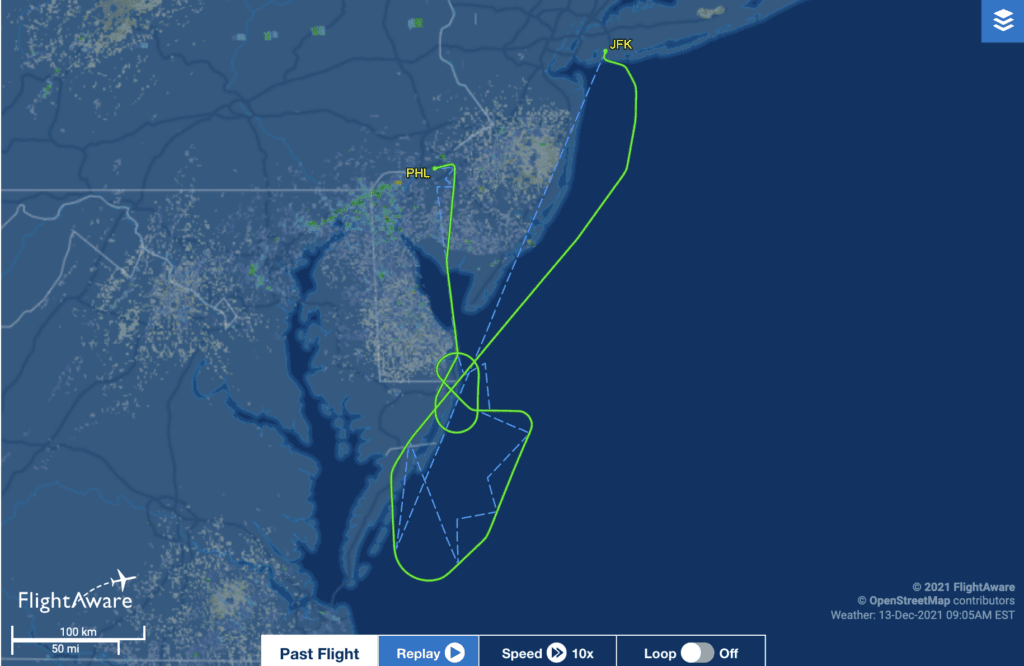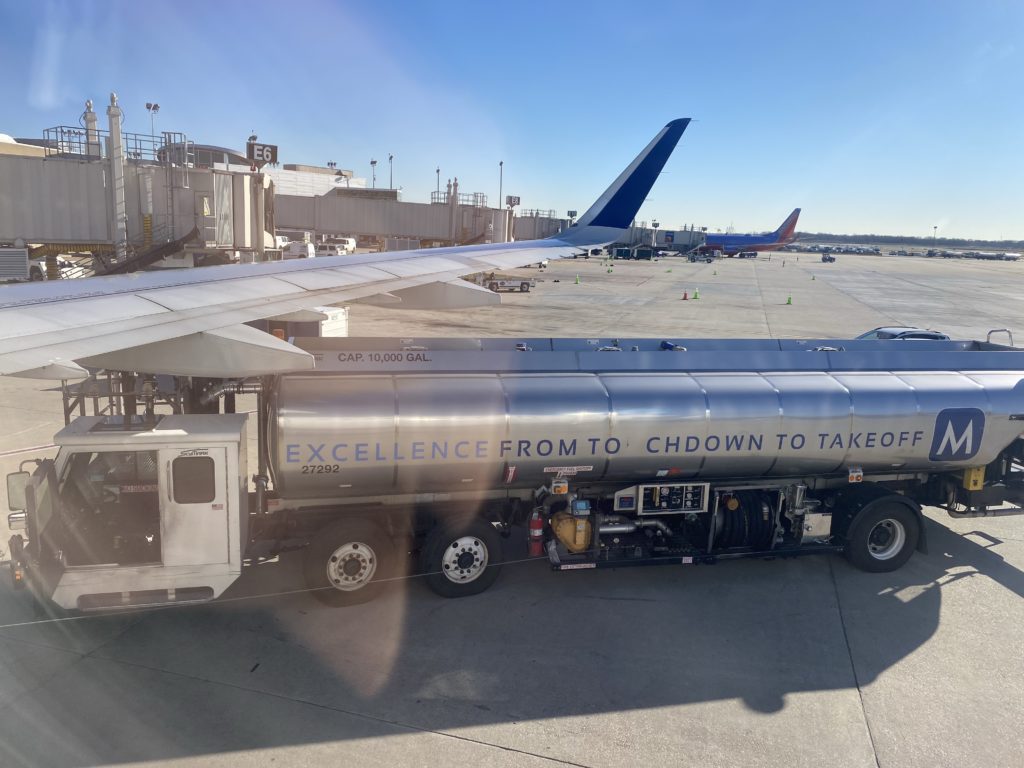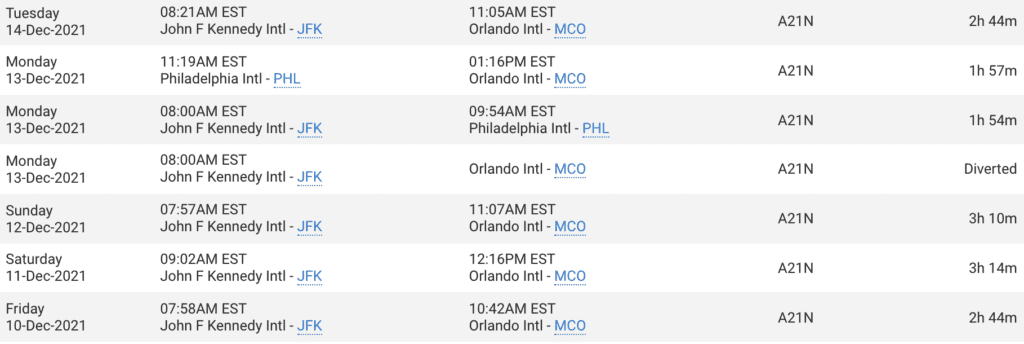On an average day, almost all flights happen as planned. Sure, there are delays but the planes travel between the city pairs as scheduled.
However, a small number of flights get diverted from their destination and land at a different airport than originally planned. There are several reasons why this can happen, including lousy weather at the destination which prevents the plane from landing, a mechanical issue that requires the aircraft to land, or if a passenger has a medical emergency. In addition, a plane can get diverted if there’s a passenger disturbance during the flight, something we’ve seen more often over the past 2 years.
On a JetBlue flight from JFK to Orlando, I experienced my first mid-flight diversion. Here’s what it was like to be on board while this was happening, and how the passengers and crew dealt with the situation.
The morning started like every other, except waking up at 5 AM to get to the airport on time for an 8 AM departure from JFK. Our flight boarded on time and we were on our way home. It was about 1 hour into the flight, just as the drink service had started, when an announcement came over the PA asking if a doctor was on board.
That’s never a good sign. So much for me getting some sleep on this flight. It was 20 minutes later when the captain got on the PA and announced that we would divert due to an emergency. The plane started a steep turn as soon as the announcement was done.
Understandably, the passengers were a bit confused. Some of them asked the flight attendants where we were headed and what would happen. They responded that they’d let us know that information as soon as they knew it.
Since JetBlue has free Wi-Fi on board, I immediately opened up FlightAware (one of my seven must-have travel apps) and looked up our flight. While they hadn’t announced it, I knew we were headed to Philadelphia. I thought this was a strange pick for a diversion as we were next to Virginia and it would take another hour to turn back and land at PHL.
We made one big loop over the Atlantic and then another smaller circle around Delaware before making a straight shot over southern New Jersey to PHL.

As we were preparing for landing, the captain again came on the PA and thanked the passengers for their understanding. The passenger was starting to feel better, but he decided to divert out of an abundance of caution. Upon landing, the medical staff would meet the plane at the gate, and once that situation was under control, we’d be heading to Orlando as soon as possible.
While on the ground, we couldn’t leave the plane but we could use the bathrooms, stand up to stretch, and such. Passengers were also reminded that they could make phone calls while on the ground if they needed and that they needed to keep their masks on at all times.
After 30 minutes, we got another update that we needed to refuel and then we’d be on the way. I had a good view of the fuel truck from my window.

In all, we were on the ground in Philadelphia for about 1 hour. We had a quick taxi and were back in the air. That’s when the captain came on the PA again. He thanked us again and said that if an emergency were happening to us, we’d want the rest of the passengers to be understanding. He also explained why we diverted to PHL. At the time of the initial emergency call, it was the closest airport where JetBlue had a presence and there was the ability to get medical help onboard quickly.
It makes sense to land at an airport you already use and have everything in place to accept a plane and turn it around. I’d imagine the severity of the emergency would also be a considering factor when deciding where to land.
In all, we arrived in Orlando about 2 hours late.

Once everything was done, I couldn’t be more impressed by how everyone dealt with the situation. The captain gave frequent updates and proactively answered questions people were likely to ask. The flight attendants kept everyone calm and provided as much information as they had at the time.
JetBlue operations at Philadelphia did a great job getting a gate ready and having the medical staff there to meet us. We didn’t wait for a fuel truck and once we had a flight plan filed, we were almost immediately pulling away from the gate. Everything worked smoothly and we didn’t waste any time while on the ground.
Even the passengers took everything in stride and I didn’t hear anyone complaining about what an inconvenience it was to land in Philadelphia, which would be a typical New York response to this kind of situation (Sharon and I both lived our lives in the metropolitan New York area- we would know).
Knowing there’s a passenger on your flight who’s having a medical emergency is a scary thing. There’s nothing you can do except hope things turn out OK and get help ASAP. Having to divert is a major event for an airline and there are plenty of things that need to get done to make it happen. In this instance, the system worked and everyone involved did a great job.
The thing I’m most impressed about is how this almost seemed to be a non-event. Things happened as if everything was happening just as it was planned. But none of it was planned. There was just a system to handle emergencies like this and it worked.
Kudos to JetBlue and everyone involved.
Want to comment on this post? Great! Read this first to help ensure it gets approved.
Want to sponsor a post, write something for Your Mileage May Vary or put ads on our site? Click here for more info.
Like this post? Please share it! We have plenty more just like it and would love it if you decided to hang around and sign up to get emailed notifications of when we post.
Whether you’ve read our articles before or this is the first time you’re stopping by, we’re really glad you’re here and hope you come back to visit again!
This post first appeared on Your Mileage May Vary

4 comments
That happened to me once on a flight from O’Hare to SFO. We were about 1 1/2 hours out of SFO when a passenger collapsed in the aisler (narrow body plane). The FA asked for a doctor and there was one sitting directly behind me. Two things stand out in my mind:
1. The man was assisted into a seat next to the doctor, who gently started to talk to the man and ask some questions. It was soon apparent the doctor was testing the man’s cognitive abilities and was giving updates to the FA.
2. The plane did not slow down and get into the normal line of traffic traveling to SFO. We pulled out in a parallel flight path and didn’t slow down at all until practically over San Jose, arriving about 30 minutes early.
By then the doctor had determined no life-threatening event had happened and all passengers deplaned as quickly as possibly so the paramedics could attend to the passenger with plenty of room.
The captain was very good but the flight attendants were amazing – extremely professional and marvelous at handling the passengers and keeping as best as possible a calm atmosphere.
I disagree with PHL. Either it’s an emergency or it’s not. I can see how too small an airport is not safe if the runway is too short. However, Norfolk (ORF) looks closer.
I have been on a Delta diversion to Keflavik, Iceland and Delta didn’t fly there at the time.
Helped out with an emergency in September. Diverted to the closest airport. Kinda wild landing while seated on the floor not belted in!
At times like these Im always reminded of an airport I neve think about. Atlantic City International. Which as I recall, when Concorde service was still around was one of the few airports credentialed for it. But I am sure there are a lot factors beyond proximity. I also wonder if the airport’s position relative to large treatment care centers factors in? In which case Phila is perhaps the best equipped city you were near.